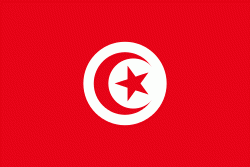Kerkennah Islands (Kerkennah)
Kerkennah Islands (قرقنة ; Ancient Greek: Κέρκιννα Cercinna; Spanish:Querquenes) are a group of islands lying off the east coast of Tunisia in the Gulf of Gabès, at 34.7°N, 11.18333°W. The Islands are low-lying, being no more than 13 m above sea level. The main islands are Chergui and Gharbi. The archipelago has an area of 160 km2 and a population of 15,501 (2014).
Kerkennah's main town, Remla (on Chergui), has a population of 2,000. The population of the islands significantly decreased during the 1980s due to drought. The islands were unable to provide suitable irrigation systems and, with clean water rapidly running out, many islanders were forced to leave for mainland Tunisia, the nearest city being Sfax.
The natives of Tunisia and Kerkennah originally settled there, but during the spread of the Roman Empire, Kerkennah was used as a port and look-out point by the Romans, to keep note of off-shore activity. In 2 BC, Augustus exiled Sempronius Gracchus, a lover of Julia the Elder, to the islands for 14 years for his indiscretions with his then-married daughter. Greeks called it Cercina (Κέρκινα) and Cercinna (Κέρκιννα). Strabo and Ptolemaeus wrote that also the city that was on the island was called Cercinna (Κέρκιννα), same as the island.
Among the Catholic bishops whom the Arian Vandal king Huneric summoned to Carthage in 484, was a Bishop Athenius of Cercina, the seat of the bishopric being in the most easterly island of the group. No longer a residential bishopric, Cercina is today listed by the Catholic Church as a titular see.
In 532, Saint Fulgentius of Ruspe built a monastery on one of the islets of the group.
During the Second World War, the Battle of the Tarigo Convoy was fought near the islands on 16 April 1941.
Kerkennah's main town, Remla (on Chergui), has a population of 2,000. The population of the islands significantly decreased during the 1980s due to drought. The islands were unable to provide suitable irrigation systems and, with clean water rapidly running out, many islanders were forced to leave for mainland Tunisia, the nearest city being Sfax.
The natives of Tunisia and Kerkennah originally settled there, but during the spread of the Roman Empire, Kerkennah was used as a port and look-out point by the Romans, to keep note of off-shore activity. In 2 BC, Augustus exiled Sempronius Gracchus, a lover of Julia the Elder, to the islands for 14 years for his indiscretions with his then-married daughter. Greeks called it Cercina (Κέρκινα) and Cercinna (Κέρκιννα). Strabo and Ptolemaeus wrote that also the city that was on the island was called Cercinna (Κέρκιννα), same as the island.
Among the Catholic bishops whom the Arian Vandal king Huneric summoned to Carthage in 484, was a Bishop Athenius of Cercina, the seat of the bishopric being in the most easterly island of the group. No longer a residential bishopric, Cercina is today listed by the Catholic Church as a titular see.
In 532, Saint Fulgentius of Ruspe built a monastery on one of the islets of the group.
During the Second World War, the Battle of the Tarigo Convoy was fought near the islands on 16 April 1941.
Map - Kerkennah Islands (Kerkennah)
Map
Country - Tunisia
 |
 |
| Flag of Tunisia | |
Beginning in early antiquity, Tunisia was inhabited by the indigenous Berbers. Phoenicians began to arrive in the 12th century BC, establishing several settlements, of which Carthage emerged as the most powerful by the 7th century BC. Carthage was a major mercantile empire and a military rival to the Roman Republic until 146 BC, when it was defeated by the Romans who occupied Tunisia for most of the next 800 years. The Romans introduced Christianity and left architectural legacies like the Amphitheatre of El Jem. In the 7th century AD, Arab Muslims conquered all of Tunisia (finally succeeding in 697 after several attempts starting in 647) and settled with their tribes and families, brought Islam and Arab culture to the local inhabitants, and since then Arabs became the majority of the population. Then, in 1546, the Ottoman Empire established control there, holding sway for over 300 years, until 1881, when the French conquered Tunisia. In 1956, Tunisia gained independence as the Tunisian Republic under the leadership of Habib Bourguiba with the help of activists such as Chedly Kallala, Farhat Hached and Salah Ben Youssef. Today, Tunisia's culture and identity are rooted in this centuries-long intersection of different cultures and ethnicities.
Currency / Language
| ISO | Currency | Symbol | Significant figures |
|---|---|---|---|
| TND | Tunisian dinar | دت | 3 |
| ISO | Language |
|---|---|
| AR | Arabic language |
| FR | French language |















